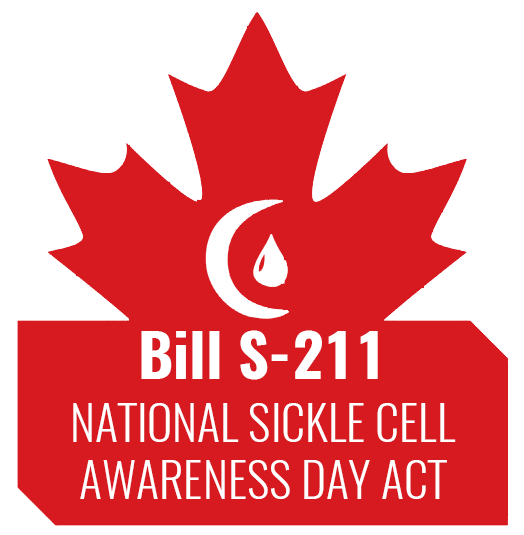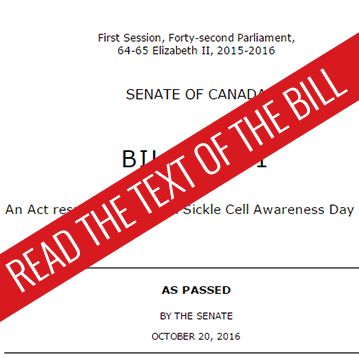GREAT NEWS!
An Act respecting National Sickle Cell Awareness Day passed unanimously in the House of Commons and
received Royal Assent on December 12th, 2017.
BILL S-211, An Act Respecting National Sickle Cell Awareness Day
 I have sponsored Dartmouth, NS Senator Jane Cordy’s Bill S-211 in the House of Commons. In the Senate, Bill S-211 passed unanimously and without amendment.
I have sponsored Dartmouth, NS Senator Jane Cordy’s Bill S-211 in the House of Commons. In the Senate, Bill S-211 passed unanimously and without amendment.
Back in September 2016, my office met with Rugi Jalloh, president of the Sickle Cell Association of Nova Scotia, along with her delegation. Each of them had compelling and personal stories of how this disease has affected their health or the health of their family members.
People with sickle cell disease frequently experience extreme pain in their bones. One person we met with has a sister who is mostly bedridden and requires home care. Another person we met had lost two family members to this disease.
Bill S-211 is an Act Respecting National Sickle Cell Awareness Day.
The bill would designate June 19th in each and every year as “National Sickle Cell Awareness Day.” June 19th was chosen to commemorate the day on which a resolution was officially adopted by the General Assembly of the United Nations, recognizing Sickle Cell Disease as a public health concern.
Why does this bill matter?
Sickle Cell Disease (SDC) is the most common genetic disease in the world. The World Health Organization (WHO) estimates that Sickle Cell Anemia affects nearly 100 million people through out the world.
The majority of these individuals will die in childhood due to lack of basic care and those who survive into adulthood will often face a life of chronic pain and premature death. Disease modifying therapy can make a difference.
What about Canada?
It’s estimated that 5000 Canadians are living with Sickle Cell Disease.
What is Sickle Cell Disease?
Sickle Cell Disease (also called Sickle Cell Anemia) is a group of red blood cell disorders you have inherited and are born with. Sickle Cell Disease is caused by an abnormal form of Hemoglobin. This is the part of your red blood cell that carries oxygen around the body and keeps your vital organs working. In Sickle Cell Disease, the abnormal Hemoglobin (HbS) is not able to work properly. The red blood cells become stiff and block up the blood vessels in your body, causing pain and damage, and they also get destroyed quickly, leading to anemia.
 What makes the red cell sickle?
What makes the red cell sickle?
There is a substance in the red cell called hemoglobin that carries oxygen inside the cell. One little change in this substance causes the hemoglobin to form long rods in the red cell when it gives away oxygen. These rigid rods change the red cell into a sickle shape instead of the round shape:
What does it mean to have Sickle Cell Anemia?
It is something you will have your whole life, and need to learn how to live with it, so that you can continue living as normally as possible, with schooling, work, and family life. As it is inherited, you also need to know your partner’s Sickle Cell status as you could pass it onto your future children too.
How does someone get Sickle Cell Disease?
Anyone can have Sickle Cell Disease or trait including Caucasians but it is seen more in people from Africa, the Mediterranean, Caribbean, Middle East, South East Asia, Western Pacific Region, South America, and Central America.
Sickle Cell Disease runs in families and is caused by a problem with the hemoglobin gene. Genes are the instructions that tell our bodies how to grow and develop. Most people have two normal copies of the hemoglobin gene – one from their mother and one from their father. A person with Sickle Cell Disease has two sickle hemoglobin genes, one from each parent. For a couple to have a child with Sickle Cell Disease, both parents must be carriers. A carrier of Sickle Cell Disease has one normal hemoglobin gene and one sickle hemoglobin gene. A carrier does not have, and will not develop, Sickle Cell Disease.
All races should be screened for this hemoglobin at birth.
